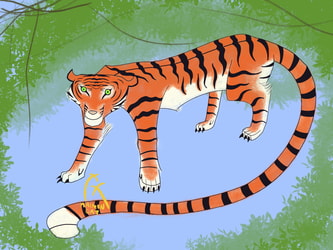Sign In
CloseThere has been a surge in depictions of celestial beings recently, that more accurately portray their descrptions from the Bible. This has lead to beautiful renditions of the beastly Cherubim, the heavenly Seraphim and the incomprehensible Ophanim, which give off that sense of immense cosmic power that the Bible describes.
However, among these “Biblically Accurate Angels” the one celestial creature that’s missing are… the angels. This is because, while we use this word to describe any being from Heaven, the Bible doesn’t use the word Malakh (messenger) when talking about a Cherub, Seraph or Galgallin. The truth is, the angels from the Bible simply look… human. Which makes sense, considering that their whole purpose is to interact with the mortal realm.
But still, they sometimes take on a nightmarish cosmic horrors, as described in Chapter 10 0f the Book of Daniel:
Then I lifted up mine eyes, and looked, and behold a certain man clothed in linen, whose loins were girded with fine gold of Uphaz:
His body also was like the beryl, and his face as the appearance of lightning, and his eyes as lamps of fire, and his arms and his feet like in colour to polished brass, and the voice of his words like the voice of a multitude.
Recentemente sono state rappresentate spesso le creature del paradiso, così come vengono descritte nella Bibbia. Da questo abbiamo avuto bellissime rappresentazioni deis Cherubini bestiali, dei Serafini celesti e degli incomprensibili Troni, che trasmettono quel senso di immenso potere cosmico descritto dalla Bibbia.
Eppure, tra tutti questi "angeli biblicamente accurati" sono venuti a mancare… gli angeli. Perché, sebbene noi utilizziamo la parola per descrivere ogni tipo di essere celestiale, la Bibbia non chiama mai i Serafini, Cherubini e Troni Malakhim (messaggeri). La verità è che gli angeli della Bibbia hanno un aspetto… umano. Il che ha senso, il loro ruolo nell’esistenza è quello di interagire con la sfera mortale.
Ma anche loro possono essere raccapriccianti orrori cosmici, come nel decimo libro del profeta Daniele:
alzai gli occhi e guardai, ed ecco un uomo vestito di lino, con ai fianchi una cintura d’oro di Ufaz; il suo corpo somigliava a topazio, la sua faccia aveva l’aspetto della folgore, i suoi occhi erano come fiamme di fuoco, le sue braccia e le sue gambe somigliavano a bronzo lucente e il suono delle sue parole pareva il clamore di una moltitudine.
Seit einiger Zeit gibt es sehr viele Darstellungen der himmlischen Wesen so, wie sie in der Bibel beschrieben werden. Davon haben wir unglaubliche Versionen von den tierischen Cherubinen, den göttlichen Seraphen und den unerkennbaren Thronen bekommen, die die kosmische Macht der Bibeltexte wiedergeben.
Und doch fehlen bei diesen "Bibelgerechten Engeln"… die Engel. Denn obwohl wir dieses Wort für jede himmlische Kreatur benutzen, nennt die Bibel selbst keinen Seraph, Kerub oder Thron einen Malakh (Boten). In Wahrheit sind die eigentlichen Engel der Bibel ziemlich… menschlich. Was Sinn ergibt, da ihr Grund fürs Dasein nur das Einmischen in der Menschenwelt ist.
Trotzdem haben auch diese Boten manchmal groteske Horror Gestalten, wie im 10. Kaptel des Buches Daniel:
Ich erhob meine Augen und schaute: da sah ich einen Mann, mit einem Linnengewand bekleidet, um die Lenden einen Gürtel aus feinstem Gold; Sein Leib war wie Chrysolith, sein Antlitz wie der Blitz, seine Augen wie Feuerfackeln; seine Arme und Beine funkeltel wie Glanzerz, und der Schall seiner Worte glich dem lärmen einer Volksmenge.
Submission Information
- Views:
- 208
- Comments:
- 0
- Favorites:
- 0
- Rating:
- General
- Category:
- Visual / Digital




